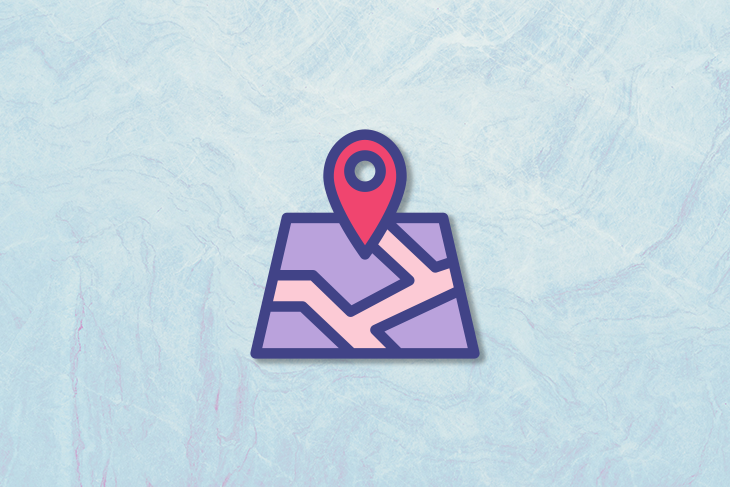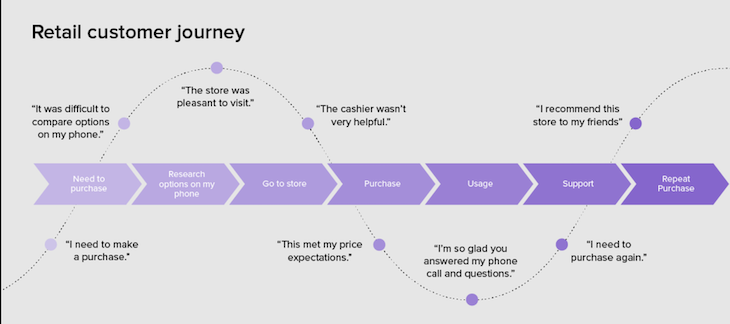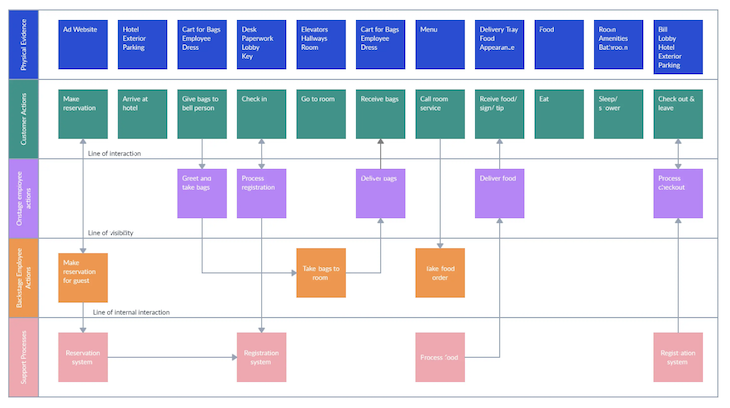
Sometimes, product managers have a tendency to only focus on product experience. However, the product is only one part of a whole experience a user has when interacting with the company.
For a more holistic approach to customer experience, you can use a service blueprint to zoom out and evaluate a customer journey with greater perspective.
In this article, you will learn what a service blueprint is, what goes into creating one, and the steps needed to successfully implement a service blueprint within your team.
Before jumping into the service blueprint, let’s briefly discuss the difference between product and service design.
A product is a tangible object that a customer can usually take possession of. A service, on the other hand, is a type of activity that a customer purchases for their benefit.
Let’s take Uber as an example.
The Uber application is a product. Users use it to achieve their objectives, which in turn drives business outcomes. Product design ensures the application is user-friendly and efficient.
Service design, on the other hand, zooms out and considers the experience as a whole.
First of all, it considers all touchpoints a user has with the service, not just the particular product. The actual service doesn’t start with the product. It starts when a user decides they need a ride.
They might then google options and have a touchpoint with Uber advertisements in Google. Then, they move to the app description and decide to download the app and order a ride.
The experience continues even without using the app. The service includes the whole pickup process, interaction with the driver, and even a confirmation email you get after the ride.
Also, not everything is visible to the user. There are many actions that happen in the background, such as the rider-side interactions, the algorithm working on finding the driver, the billing service that counts the fare.
While product design is all about optimizing an encapsulated experience within one touchpoint, a service design considers the holistic experience, both from a user perspective (what happens before and after using the product), as well as a business perspective (what happens in the background to make that experience happen).
A service blueprint is one of the main tools used for service design. It’s a visualization of both the whole user journey and all the background processes that happen during the service.
Service is often considered a physical interaction, such as going to a restaurant or getting a haircut. However, digital product managers can also benefit seeing from how their product fits the bigger picture.
It’s especially critical if you are working on a product that’s part of a bigger service, such as:
The service blueprint visualizes the whole service by mapping everything that’s happening. It usually splits into five distinct sections:
It all starts with a user. A good service is built based off of the journey the user has to take to achieve their objectives and fulfill their needs:

Understand the problem your service is supposed to solve and what steps users naturally take to try to solve the problem. Then you can build your service around this journey and its pain points.
What are the visible parts of your service? These are all interactions with users and other activities visible to users that need to happen to provide extraordinary service.
For example, in the case of a restaurant visitor, it could include:
Now that you mapped what happens in front of the user, you need to map out the things that happen backstage.
Backstage actions focus on work done by employees that’s not visible to end-users, yet still impacts their experience.
These could include things like checking to prepare the meal of users or delivering the food to customers.
Mapping these actions is critical because:
It doesn’t matter how exceptional your service is. It matters how users actually perceive the service. They don’t judge it based on the effectiveness of your processes and backstage actions, but on the evidence of quality they see.
You can treat physical evidence as all direct user touchpoints that impact their perception of the service. This could include:
Support processes include everything that impacts the whole service, but doesn’t require an active action on the customer or employee end.
Consider everything that automatically happens in the background, as well as regulations and processes that guide backstage and frontstage actions.
These could include things like:
Now let’s look at a few examples of real-word service blueprint examples:
A service blueprint for a hotel might look something like this:

An online shopping experience could follow this service blueprint:

The service blueprint of a hotel might follow:

Creating a service blueprint is a time-consuming and complex process. However, the benefits often outweigh the costs. Let’s review a few benefits of creating a service blueprint:
Mapping the whole service helps the team establish the big picture.
It not only shows how the service works as a whole, but can also showcase how other teams’ work impacts the experience.
It often sparks interesting conversations between various teams on how they can collaborate to drive outcomes together. It also shows what’s already in place in different parts of the experience (i.e., what can be reused in a different place to make the whole experience better) and is a good source of inspiration for new ideas.
While the user journey itself can tell you what problems and challenges the user faces in order to achieve a desired outcome, a service blueprint can help you identify the invisible root causes of these problems.
It makes the whole process of improving user experience way easier.
It’s rarely prioritized, but looking at the efficiency of the whole process is also a critical part of service design.
A service blueprint shows you what happens in the background and might give you ideas on how to make the whole process more efficient. Even if it doesn’t directly impact user experience, improving processes can help you free up resources to further develop the user-impacting parts of the journey
You can follow these steps to map out your own service blueprint:
Start with defining what the customer wants to achieve and why.
A robust service blueprint focuses on helping users achieve their main objectives. So, for example, if you are designing banking services you might include:
Even though these will have many shared parts, these are actually four different services that should be represented by four separate blueprints.
Don’t try to make one service blueprint that showcases all possible scenarios.
Now that you know which scenario you are going with, map out the journey the customer has to take to fulfill the scenario.
If you are just starting with service blueprinting, I’d recommend you focus on the steps the user has to take. In the future, you might add more context, such as user pain points or happy moments, but I’d go with simplicity for the first draft.
Identify the main touchpoints that the customer experiences during their customer journey that will affect how they perceive the service as a whole.
At the end of the day, the whole process of designing a service is to make these touchpoints as smooth and efficient as possible.
Once you have identified key touchpoints, map out the visible front stage processes that must happen to make these touchpoints a reality and how they affect the quality of the touchpoints.
Now identify all backstage actions, that is, actions done by employees, but not visible to end users, that will impact the overall quality of the customer journey.
After this, map all processes that support these actions.
Whether these are live actions done by IT systems or procedures and regulations that affect the behavior of frontstage and backstage actions, everything that indirectly impacts the final customer experience is essential.
At this point, you should have a clear snapshot of how the service as a whole looks like. The last step is to identify potential points of improvement and inefficiencies that should be addressed.
Treat the whole service experience like a product — inspect it regularly, come up with hypotheses on how to improve it, run small experiments, and validate if they improved the experience.
There’s no point in mapping the whole service if you don’t take any actions based on it.
Keep in mind that there’s no one proper way to do so. Depending on your context, it might make sense to start from support processes and make your way up to the user journey. Just remember that the ultimate purpose of the service is to make the life of the end-user better, which in the long-run leads to better business outcomes.
A service blueprint helps you visualize the journey — including the customer, employee, and process perspective — that’s required for the customer to achieve their objectives.
It includes:
All these build a cohesive picture of what needs to happen to achieve the desired outcome.
Treat the service the same way you treat products. Inspect it regularly, come up with improvement ideas, and test them on a regular basis.
At the end of the day, users won’t judge you based on the particular product you offer, but on the whole experience they get from interacting with your offering.
Featured image source: IconScout
LogRocket identifies friction points in the user experience so you can make informed decisions about product and design changes that must happen to hit your goals.
With LogRocket, you can understand the scope of the issues affecting your product and prioritize the changes that need to be made. LogRocket simplifies workflows by allowing Engineering, Product, UX, and Design teams to work from the same data as you, eliminating any confusion about what needs to be done.
Get your teams on the same page — try LogRocket today.

Red-teaming reveals how AI fails at scale. Learn to embed adversarial testing into your sprints before your product becomes a headline.

Cory Bishop talks about the role of human-centered design and empathy in Bubble’s no-code AI development product.

Learn how to reduce mobile friction, boost UX, and drive engagement with practical, data-driven strategies for product managers.

Jim Naylor shares he views documentation as a company’s IP and how his teams should use it as a source of truth.